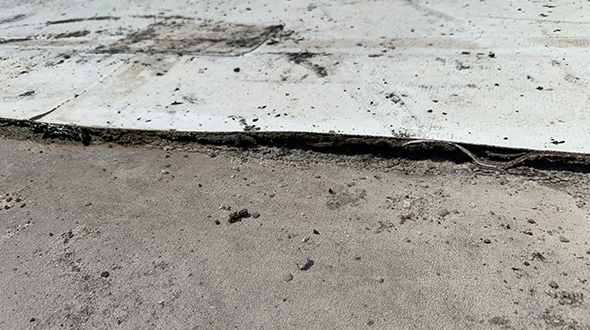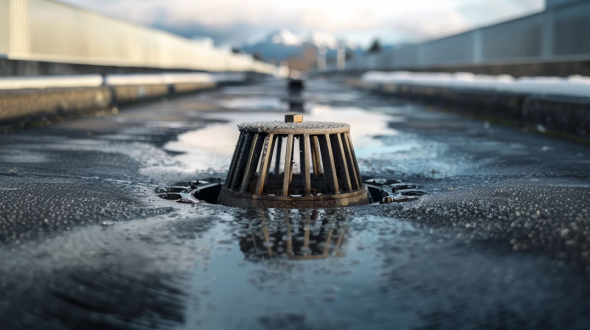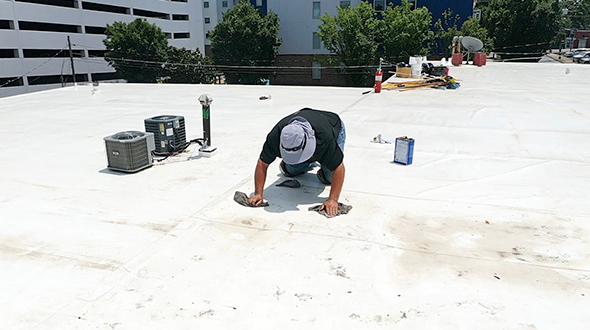Dealing with flat roof issues can be frustrating and costly. From leaks and ponding water to sun damage, these problems not only inconvenience you but are costly and pose threats to your property. This article provides practical solutions to address these issues effectively. You can expect clear advice on identifying and resolving common flat roof problems while ensuring the longevity of your roofing system.

Key Takeaways
- Flat roofs are susceptible to a range of issues, such as leaks, ponding water, blistering, and UV damage, which require regular inspection and maintenance to prevent and address.
- Repair solutions include using quality materials, ensuring adequate drainage, addressing defects such as blisters, and protecting against UV damage with protective coatings.
- Regular flat roof maintenance is vital for longevity, including semi-annual inspections, debris removal, and preventive measures such as using durable materials and appropriate sealants.
Flat Roof Issues: Identifying the Problem
Flat roofs are not immune to the adversities of weather and time and often grapple with various issues. Knowledge and a proactive approach are key in navigating these challenges and ensuring the longevity of your roof. Some common problems that can arise include:
- Damage from a harsh climate
- Rapid temperature fluctuations
- Pest-related damages
- Debris accumulation
- Undue stress on the roofing system
Addressing these issues promptly is important to prevent further damage and maintain the integrity of your flat roof.

But how can you identify these issues before they escalate in commercial buildings? Regular inspections are your first line of defense. Look for signs of mold, wet spots, and leaks inside your building. On the exterior, check for accumulated debris, visible damage, and signs of ponding water. Ignoring minor issues can lead to premature roof failure, a major consequence of neglect.
Let’s delve deeper into some common flat roof problems that most commercial flat roofs and homes with flat roofing systems may encounter.
Leaky Flat Roofs
Leaks are a common bane for flat roofs. Unlike sloped roofs, their design can reduce water-shedding effectiveness over time if not properly maintained. Multiple factors contribute to this issue, including:
- Cracks in the roofing material
- Holes from fallen branches
- Improper installation
- Damaged roof components such as vents, HVAC units, and skylights
Another primary cause of leaks in flat roofs is:
- Open or damaged flashing, which requires sealing and biannual checks to prevent water ingress
- Wear around skylights
- Punctures in the roof membrane from debris like nails
As with many roofing issues, early detection is crucial in managing leaky flat roofs.
Ponding Water Dilemma

Ponding water is a frequent issue on flat roofs, primarily due to insufficient slope that does not facilitate proper water drainage or blockages that prevent water from draining within an acceptable timeframe. If left unaddressed, stagnant water can lead to material deterioration, growth of algae or vegetation, and ultimately, roof leaks and potential structural damage.
This issue is not just a symptom of a minor problem but can also indicate underlying complications, such as the building settling affecting the roof slope or compressed substrate boards. Therefore, it’s essential to regularly monitor and inspect your flat roof for signs of ponding water to ensure robust leak prevention.
The Blistering Problem
Blistering on flat roofs refers to the formation of bubbles or raised areas where the roof membrane has separated from the layer below. This usually occurs due to a decrease in the roof’s adhesive properties and thermal movement, allowing moisture to become trapped and form bubbles.
If left unattended, trapped moisture can cause blisters to grow and pop, leading to further damage, such as membrane cracks. It’s crucial to address these blisters promptly. If neglected, EPDM membrane blisters may tear and create more significant issues, marking improper installation and potential underlying damage.
UV Damage Consequences

UV damage is another significant concern for flat roofs. It manifests as:
- Fading
- Discoloration
- Cracking
- Brittleness of the roofing material
In warmer regions, flat roofing materials can deteriorate even faster due to intensified UV damage on flat roof surfaces, making solar panels a viable consideration for energy efficiency.
A common consequence of prolonged sun exposure is a condition called ‘alligatoring,’ where the flat roof begins to crack and bubble, resembling an alligator’s skin. To avoid such damage, it’s crucial to use UV-protective coatings or membranes and maintain these protective qualities through regular cleaning and maintenance.
Repairing Your Flat Roof: Solutions and Tips
The good news is that these flat roof problems can be repaired, and their recurrence can be minimized with proper maintenance. It’s generally best to consult professional roofing contractors for flat roof problems, as DIY fixes can sometimes lead to further damage and more costly repairs in the future.
When it comes to repair strategies, here are some key steps to follow:
- Use high-quality materials from reputable manufacturers.
- Ensure proper roof insulation to mitigate thermal shocks.
- Conduct regular inspections to catch problems early.
By following these steps, you can effectively address the issues we’ve identified.
Mending Leaks
When dealing with a leaking flat roof, the first step is to identify the source. For small leaks around flashing, vents, and seams, roofing cement can be used to seal these areas effectively. However, larger leaks may require a more durable repair, which can be achieved by applying a flat roof membrane in conjunction with roofing adhesive.
Remember, when encountering unusual findings during roof inspections, it’s best to consult with roofing professionals immediately. Promptly addressing leaks can save you from costly repairs down the line.
Improving Drainage

The key to reducing the issue of ponding water on flat roofs is to improve drainage. This can help prevent water from accumulating and causing potential damage. Some effective solutions include:
- Regular cleaning of the drainage system
- Upgrading the drainage system
- Installing scuppers
- Replacing old gutters and pipes with new, more efficient ones
By implementing these measures, you can effectively address the issue of ponding water on your flat roof.
Adding extra drains or constructing tapered sections on a flat roof can significantly improve water flow and mitigate ponding issues. Flat roofs can also be retrofitted with tapered insulation systems to direct water toward drains and alleviate water accumulation.
Tackling Blisters and Cracks
Addressing blisters and cracks on flat roofs requires a professional touch. The professionals will ensure proper ventilation and the use of high-quality materials. The process involves:
- Cutting out the damaged areas
- Clearing any trapped water or debris
- Cleaning the area thoroughly
- Allowing it to dry fully
After drying the area where the blisters were removed, carefully slice the top to release any remaining moisture, apply roofing cement, and secure the surface. For deeper cracks, a combination of roofing mesh and cement is applied to ensure a durable repair.
Combating UV Damage
Combating UV damage on flat roofs involves applying UV-protective coatings or membranes to shield the roof from sun damage. Reflective roof coatings can deflect sunlight away from the building, reducing heat absorption and the subsequent impact of UV rays.
Cool roof coatings help reflect more sunlight and absorb less heat, which curtails the effects of UV rays on the roofing materials. The roof’s UV protection can be prolonged through the regular re-application of a roof coating every few years.
Routine cleaning of flat roofs contributes significantly to their maintenance by keeping surface temperatures low, thereby enhancing energy efficiency and roof life.
The Importance of Flat Roof Maintenance
Regular inspection and maintenance are crucial in preventing issues and extending the roof’s lifespan. Being proactive and regularly maintaining your flat roof is key to protecting your investment and ensuring the safety and security of your property. Most flat roof maintenance programs include thorough inspections every six months and after significant storm events.

Keeping a clean roof makes it easier for maintenance teams to identify and address minor repairs before they become major problems. Let’s delve deeper into the importance of cleaning and inspecting your roof and the preventive measures you can take to maintain it.
Cleaning and Inspecting
Ideally, flat roofs should be inspected twice a year, once before and once after the rainy season, to detect early signs of wear, such as cracks, blisters, and punctures. Keeping the roof clean is essential for maintenance and can include debris removal through methods such as picking up, leaf-blowing, or pressure-washing. Clogged drains must be cleared to avoid poor drainage.
Professional roofing contractors should conduct annual inspections to check membrane integrity and provide targeted solutions for repair, including the application of sealants and the removal of vegetation to maintain commercial roof integrity or recommend a roof replacement if necessary.
Preventive Measures
Preventive measures are crucial in maintaining the longevity of your flat roof. Here are some tips to help you prevent damage:
- Use durable materials like EPDM for UV protection
- Apply proper sealants to prevent leaks and water damage
- Apply materials dry to prevent blisters
- Allow sealing substances to dry thoroughly after exposure to moisture
By following these tips, you can ensure the long-term durability of your flat roof.
Applying materials with reflective properties, such as certain types of sealants, helps to reduce heat absorption and can also lower energy costs. Also, pest-related damage can be prevented by sealing off roof access points, using bird deterrents or nets, and consulting a pest control expert if necessary.
Choosing the Right Flat Roof Repair Service
When it comes to choosing the right repair service for your flat roof, it’s important to verify that the contractor is fully licensed and insured. Verifying their qualifications provides legal protection and assures their professionalism. Experienced and qualified flat roof contractors contribute to the roof’s longevity and a thorough approach to maintenance and repair.

Conduct research on the roofing company and obtain referrals and reviews to assess the contractor’s reliability and the satisfaction of past customers. Be wary of contractors presenting significantly lower quotes, as these may reflect compromises in material quality or workmanship.
Ensuring the details of the work are documented, and the warranty specifics are well understood helps to protect against future issues with the quality of the repair.
Flat Roof Problems Summary
In conclusion, maintaining a flat roof requires knowledge, proactive inspections, and timely repairs. From leaks to ponding water, blistering, and UV damage, various issues can affect the longevity of your roof. Regular cleaning, inspections, and preventive measures are key to ensuring the safety and durability of your roof. Choosing a professional, experienced, and reliable flat roof repair service is crucial in this process. Remember, a well-maintained flat roof is an investment that protects your property and ensures its longevity.
Flat Roof Frequently Asked Questions
These are the most common questions asked of our flat roof repair team in Atlanta:
What is the average life of a flat roof?
The average life of a flat roof is about 20 years, but proper maintenance and quality materials can extend its lifespan significantly.
What is a concern when using a flat roof?
A concern when using a flat roof is the lack of drainage, which can lead to clogging and water accumulation if not checked regularly. Be sure to inspect the roof frequently to prevent drainage issues.
What are the disadvantages of a flat roof?
Flat roofs have disadvantages such as reduced stability, poor drainage, and less insulation, which can lead to issues with maintenance, repairs, and energy efficiency. Consider these factors when deciding on a roofing type.
How can I fix leaks on my flat roof?
To fix leaks on your flat roof, you can use roofing cement for small leaks and a fiberglass membrane with roofing cement for larger ones. For complex leaks, it’s advisable to seek help from a professional roofing contractor.
How often should I inspect my flat roof?
You should inspect your flat roof twice a year, before and after the rainy season, to detect early signs of wear, such as cracks and blisters. Regular inspections are crucial for maintaining the roof’s integrity.
(404) 220-9288
The post Flat Roof Problems appeared first on atlantacommercialroofingcontractors.com
